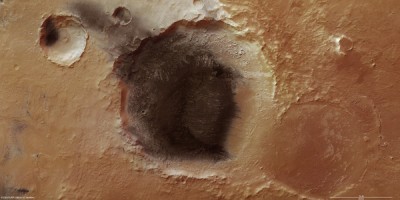Airborne volcanic ash has once again been obstructing air traffic over Europe this past week. This would be an even bigger problem on Mars, where ash particles travel much farther due to weak gravity and a thin atmosphere. (Luckily, Mars does not have much air travel at this time).
Does Mars have volcanoes? You bet! The Red Planet is home to the biggest volcano known to man. Olympus Mons rises 27 km above the median Martian surface level. This makes it three times taller than Earth’s Mount Everest! And it is 2.6 times taller than Mauna Kea measured from the base on the ocean floor to the top!
I wonder how long it will be until human mountaineers summit Olympus Mons for the first time. It would be a long and strenuous climb, but all equipment would weigh only 38% of its heft on Earth. It seems far fetched, but I would be willing to bet that some day in the distant future, explorers will seek out the challenge of climbing the tallest mountain in the Solar System on foot.
But back to volcanic ash. Today, ESA released some amazing images of volcanic ash deposits in the Meridiani Planum, as seen by the Mars Express High Resolution Stereo Camera.
Meridiani Planum, a plain at the northern edge of the southern highlands of Mars, is half way between the volcanic Tharsis Region to the west and the low-lying Hellas Planitia impact basin to the south-east. Through a telescope, Meridiani Planum is a striking, dark feature, close to the martian equator.
It extends 127 km by 63 km and covers an area of roughly 8000 km², which is about the size of Cyprus. It was chosen as a central reference point for Mars’ geographical coordinate system. So the martian prime meridian, the equivalent of the Greenwich, UK, prime meridian on Earth, has been set to run through this region.
In the center of this image is a 50 km wide impact crater. The black material appears to be volcanic ash composed of pyroxene and olivine. Martian winds must have whipped some of the stuff out of the crater and plunked it down in the region on the upper left. More ash was tossed into a smaller impact crater in the 10 o’clock position.
Volcanoes are not unique to Earth. Unmanned spacecraft have even found signs of active volcanic activities on moons such as Io, Enceladus, Triton and Europa.

